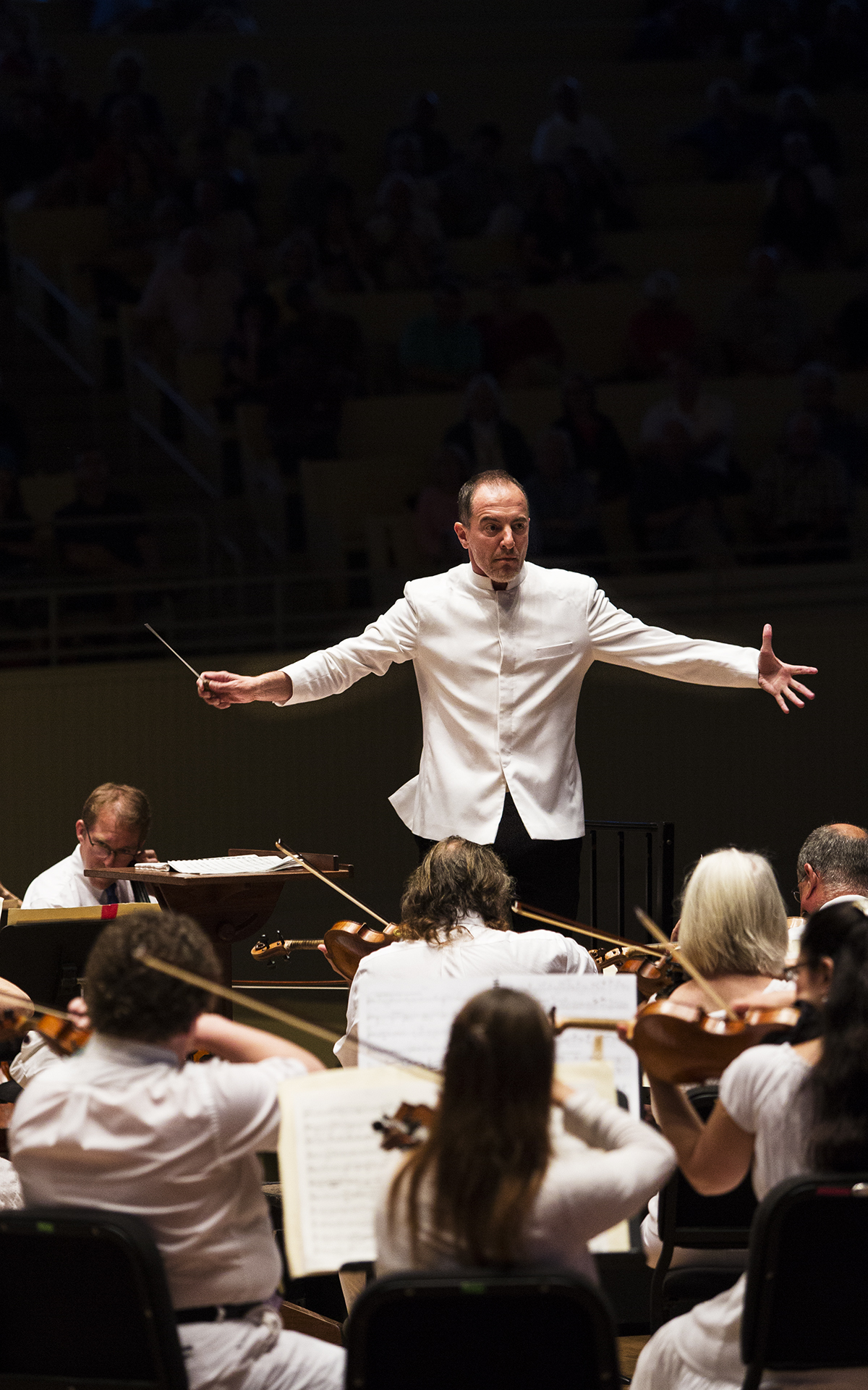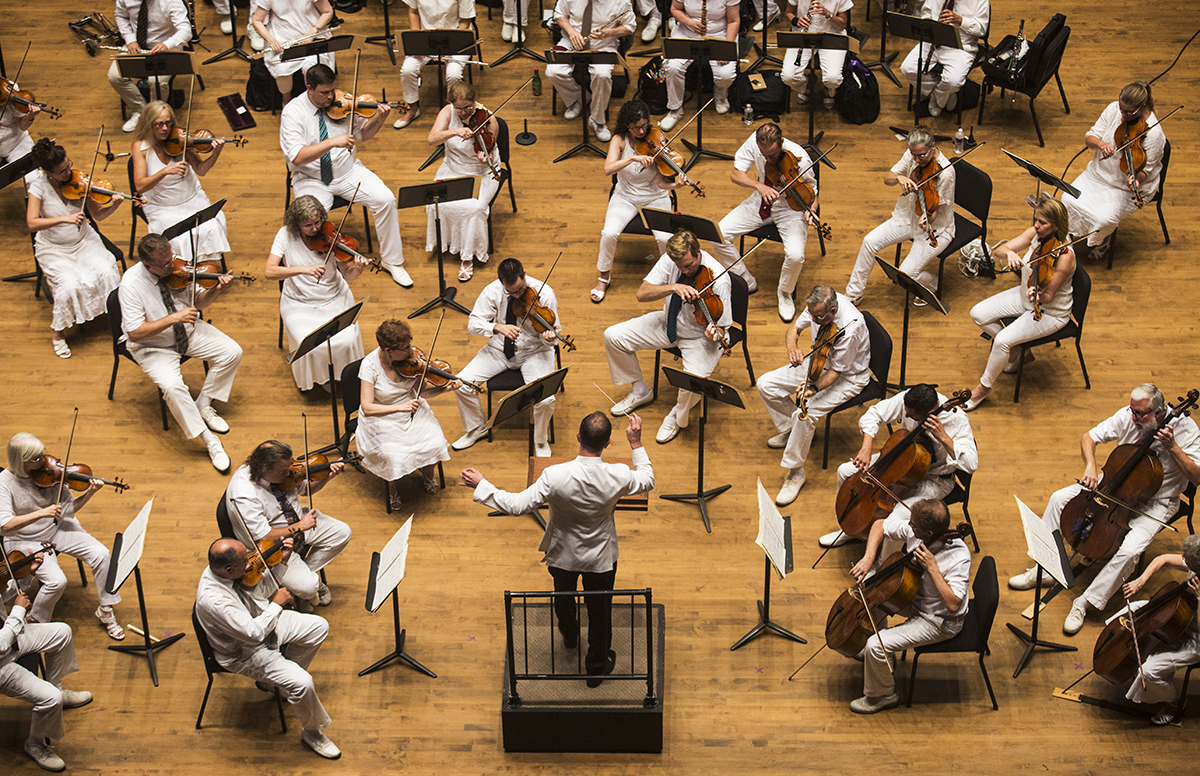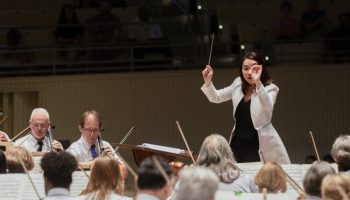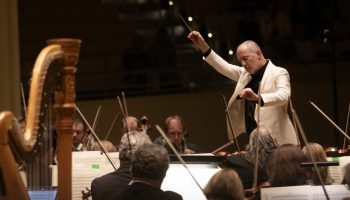Audiences have invented its nickname: The Titan. The Giant. These are among them. They are quantitative. Gustav Mahler’s Fifth Symphony is long — about an hour and 10 minutes. It demands a large orchestra with a lineup of brass and percussion to form a gravitas. The symphony owns a big, contrastive sound, covering the ground, first one thing and quickly the next.
Please allow a qualitative addition: The Big Idea.
Because this Fifth takes on the lifeline of Death to all that leads there.
All of life should merit a fanfare, so first off Mahler provides fanfare notes for Charles Berginc’s trumpet, which introduces a somber funeral march — suggestive of Beethoven’s fanfare in his Fifth. The symphony concludes with a magnificent rondo, more than an hour later, suggesting through its counterpoints the big picture complexity of an ongoing fugue of life: A bunch of Big Ideas.
The orchestra was en pointe throughout, as its own magnificence, which was immediately recognized with quick bravo and sustained, standing applause. Truth is, though, that the audience could hardly avoid being primed by the new community culture at Chautauqua, inspired by first-year President Michael E. Hill. There seems a fresh joie de vivre.
Most attending the evening Amphitheater concert on Thursday evening walked a phalanx of diverse music — a pop-up parade of opera buffs singing their way to mini concerts in various places on the grounds and separate buskers as well, playing on Bestor Plaza with wind instruments in quartet over here, a duo of flutes over there, and others by the Colonnade, all to the pleasure of changing audiences of 100 to 10.

Deborah Sunya Moore, vice president and director of programming at Chautauqua, called it in her welcome to the CSO symphony. She proclaimed a design for this year that stretched from the new to the old, from the timeless to the contemporary, from Beethoven to music from “Harry Potter”: a playful, welcoming, diverse approach. There is lightness in the air, which counterbalances any gravity. So that while the first movement of the Fifth leads from fanfare announcement of a mournful procession, a lovely melody overplays the weighted foundation of Stuart Chafetz’s light timpani and Frederick Boyd’s fundamental tuba. Something’s up, we know. But it is not yet the end of the world.
The sound shape of this Fifth is not flattened by facile melody; it is fluid, varied, surprising and organic. Right when you think you know where you are and what comes next, Mahler supplies a change in direction, often with a sudden interruption from the horns. This well qualifies as a subject in itself: That change is the order of this new early 20th century (a 1904 premiere in Cologne) and continues defiantly into the beginnings of our time in the 21st.
The power of the heavens is not far away, awaiting the time for thereafter. For here and now, a distant softness becomes lost in a rumble of percussion and a defiant stroke from the cellos.
Rage, rage against any dying of the light.
The second movement suggests that this is an undertaking, so a riotous commitment of the full orchestra hides even a bark from The Dog I have awaited in the past several years. Dog usually makes his declarations at key moments, his chains rattling in the third movement, too.
And then a soft entrance for a handsome gong, a delicacy outcoming from the center of the riot. Articulate under the leadership of Maestro Rossen Milanov was a circular architecture for the symphony, like a rolling wheel that often allows penetration into a sphere of sound drawn across the full orchestra, an opening for new sound light, such as a quiet underbelly from the timpani against a calm growth in the amplitude from the cellos.
This is why we came to the orchestra, for these discoveries, which for every reason remain personal, our purpose being the aesthetics of finding for ourselves that breakthrough into significance. This is why it matters, across the Institution, that music is encouraged to pop up with other ideas, is distributed in large settings, like the Amphitheater, or in passing on a porch or surprised by a piano heard through an open window. There is joy of findings with the lightness in the air. And we do it together, in community, locating shared grounds.
Our responsibility is to become aware and then sustain it as something precious; give this process a name and carry it on for sharing elsewhere. Mahler in the Fifth may start local, still with a touch of the waltz of just folks around Vienna, but its invention ultimately goes to the spirit. That was why, in addition to the CSO’s performance and interpretive excellence, the audience was so ready to rise to their feet, sustain recognition and discuss it with others.
There is a rhetoric to this, cousin to the great laws of the universe, easily related to comparison and contrast and the effective use of repetition. Thus, the third movement finds in the wheels of repetition an opening into the radiance of the fourth movement’s famed Adagietto, all strings, slightly quicker than an adagio, flawless.
In the third there is a summer breeze that as it hits a soft wall, it becomes a dance in the village, or something more assertive, such as a deconstruction of the chords of a gentle wind, awaiting an oboe to announce the forthcoming repeat, that can get rough. And then the fourth, which does anticipate an exciting, inspiring finale.
The rondo of the fifth is at once playful, gentle and mighty, fully dimensional. It becomes skinny and it grows large and skips around obstacles with an unorthodox logic. It aspires to great heights and invents new ways to get there. It is exhausting and exhilarating.
When all was said and done, Maestro Milanov quickly brought the entire orchestra to its feet. He put his hand to his heart as he took his leave, then brought two hands to his face. Returning, he could have held the stage for a long time, applause continuing. His work with Mahler’s Fifth was that commanding.
Anthony Bannon retired with emeritus status from The Burchfield Penney Art Center, a multi-arts presenter at SUNY Buffalo State. He was the longest serving director of George Eastman House and for almost 20 years an arts writer for The Buffalo News.





